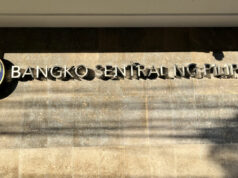Liquidity expands faster in May
MONEY SUPPLY growth logged a faster pace in May on the back of liquidity-boosting measures from the central bank and the National Government to help the country weather the pandemic’s fallout.
Domestic liquidity or M3, the broadest measure of money supply in an economy, rose by 16.6% year on year in May to P13.7 trillion, quickening from the 16.2% seen in April, data from the Bangko Sentral ng Pilipinas (BSP) showed. M3 picked up by 0.6% month on month.
The growth was mainly driven by demand for credit, the BSP said. Money supply has been growing at a faster rate since March.
Net claims on the central government increased 59.6%, faster than the 45.5% logged in April. This was due to higher domestic borrowings by the National Government, the BSP said.
Meanwhile, domestic claims climbed 16.2% in May, quicker than the 15% the month prior.
Net foreign assets in peso terms also expanded by 12.1%, coming from the 11.9% seen in April.
ING Bank N.V. Manila Senior Economist Nicholas Antonio T. Mapa said the improvement in liquidity came on the back of the government’s local borrowing as well as central bank moves meant to help the financial system amid the crisis.
“Reductions to reserve requirements and the recent repurchase agreement with the national government have all helped bolster liquidity with flows totaling P581 billion by May,” Mr. Mapa said in an e-mail.
The central bank slashed the reserve requirement ratio (RRR) of universal and commercial banks by 200 basis points (bps) to 12% in April in a bid to boost liquidity during the lockdown. This followed the 400 bps in RRR reductions done in 2019.
The Monetary Board has authorized RRR cuts of up to 400 bps this year.
The BSP also bought P300 billion in government bonds through a repurchase agreement with the Bureau of the Treasury in March.
“For the coming months, M3 growth could still pick up amid possible cut in banks’ RRR in the coming months as well as the maturing government securities worth about P100 billion in August,” Rizal Commercial Banking Corp. Chief Economist Michael L. Ricafort said in an e-mail.
BANK LENDING SLOWS
Meanwhile, bank lending continued to log a slower growth print in May, with analysts saying credit may pick up in the coming months as the economy gradually reopens.
Outstanding loans disbursed by universal and commercial banks rose 11.3% in May, easing from the 12.7% print in April, the BSP said in a separate statement on Tuesday.
Inclusive of reverse repurchase agreements, bank lending picked up 10.3%, slower than the 10.9% growth the previous month.
Production loans, which made up 87.1% of total lending in May, was the principal driver of growth, even as it expanded by a slower 9.8% versus the 11.1% seen in April.
The BSP said the sustained increase in production loans was driven by the expansion in credit to sectors such as information and communication (24.9%); transportation and storage (20.4%); real estate activities (19.6%), financial and insurance activities (13.9%); and electricity, gas, steam and air-conditioning supply (8.6%). Lending to other sectors also picked up in May except for mining and quarrying (-5.6%), professional, scientific, and technical services (-23.4%), and manufacturing (-3.2%).
Consumer loans also saw a slower growth of 30.2% in May from the 33.3% in April amid a slowdown in credit card and motor vehicle loans.
“Amid the challenge of keeping credit flowing to affected businesses and households, the BSP has adopted a range of measures to support bank lending, including a further reduction of the policy rate to complement the various liquidity-enhancing and regulatory measures by the BSP,” the central bank said.
“The BSP reassures the public of its commitment to deploy its full range of instruments to ensure that domestic liquidity and credit remain adequate amid the ongoing coronavirus pandemic,” it added.
The central bank last month slashed benchmark interest rates by 50 bps, bringing the rates on the overnight reverse repurchase, lending and deposit facilities to record lows of 2.25%, 2.75% and 1.75%, respectively.
The BSP said it chose to keep an accommodative stance to support the country amid dimming global economic prospects due to a worsening fallout from the coronavirus pandemic.
The record-low rate environment could encourage borrowers to take out loans from banks to finance business activities and their household needs, RCBC’s Mr. Ricafort said.
“The further reopening of the economy starting June could lead to a corresponding pick up in the demand from loans as more businesses further reopen from lockdowns and more individuals return to work,” he added, saying manufacturing and imports will pick up in the coming months and could bolster loan growth as well.
ING’s Mr. Mapa said the central bank has already done its part in helping the economy as far as monetary policy support is concerned.
“It appears that we are in the situation that no matter how many times BSP may cut policy rates, incomes and consumer confidence will need to be restored or replaced to get the economic engines running once again,” he said.
“[U]nless we get fresh spending measures off the table to “plant the seeds of recovery,” we will be staring at an empty field with no crops or produce to show for it,” Mr. Mapa added. — Luz Wendy T. Noble



